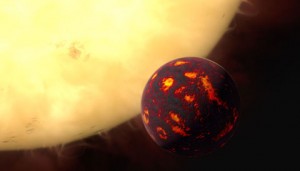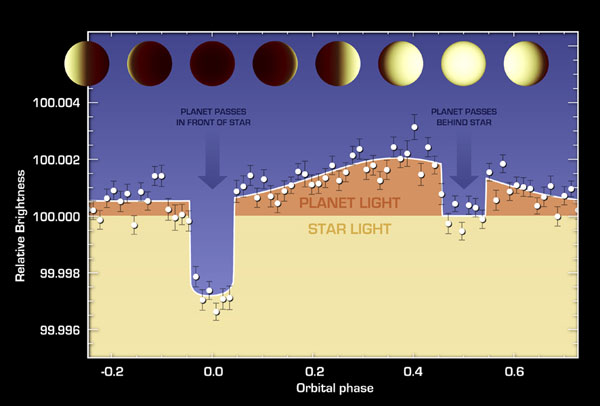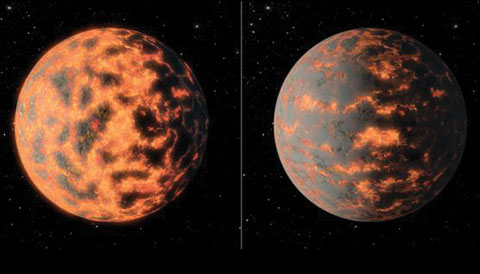Volcanic wasteland or exotic, two-faced atmosphere? A new thermal map of this super-Earth exoplanet is puzzling astronomers.

ESA / Hubble / M. Kornmesser
Super-Earths may rule the galaxy, but boy are they weird. And 55 Cancri e, recently renamed Janssen, tops the charts in weirdness. At eight times Earth’s mass and twice its radius, this mostly rocky planet straddles the line between Earths and Neptunes. It zips around its Sun-like star in less than a day, a proximity that leaves its surface roughly 30 times hotter than Earth’s.
From the beginning, 55 Cancri e has had scientists proposing all kinds of bizarre theories: a planet-wide ocean, diamonds in its interior, and even active volcanoes riddling the surface. Now research published March 30th in the journal Nature adds another piece to the puzzle.
55 Cancri e’s Sweltering Days and Nights
Brice-Olivier Demory (Cavendish Laboratory, UK) and colleagues basically used the Spitzer Space Telescope as night vision goggles, taking thermal images of the planet as it spun around its host star. The team collected 75 hours’ worth of observations in the span of a month in the summer of 2013.

NASA / JPL-Caltech / University of Cambridge
55 Cancri e is tidally locked, which means the same side is always facing the stellar fire. And the first thing that jumps out of the data is that while 55 Cancri e’s nightside is hot (2000°F, or 1400K), its dayside is even hotter: 4400°F (2700K).
Never mind that the temperatures themselves would melt lead. (In fact, the dayside would even melt sapphires — but not diamonds.) It’s the difference between the two hemispheres that’s boggling astronomers’ minds. What it means is that either this planet has no atmosphere at all (the Moon’s windless sphere likewise has a 500°F difference between its day and night sides), or its atmosphere is curiously bad at recirculating heat.
Add to this conundrum the team’s second discovery: the hottest point on the planet is not directly in the middle of the star-facing side; it’s shifted a full 40 or so degrees east. That’s a big shift for a non-circulating atmosphere. If winds aren’t pushing the hot spot over, the authors propose that we may instead be seeing an eastward magma flow on the planet’s surface.

NASA / JPL-Caltech / University of Cambridge
Magma Flows or a Two-Faced Atmosphere?

NASA / JPL-Caltech / R. Hurt
That’s not as crazy as it sounds— magma isn’t a new concept for this planet. Last year, Demory and colleagues published a report that showed the planet’s dayside temperatures almost quadrupled over the span of a year. Unlike the thermal map they’re publishing today, those observations only occurred during transits and occultations, when the planet passed in front of and behind its host star. At the time, the authors suggested planet-spanning volcanic activity could have caused the change.
“The danger in science is that you start to become convinced by an explanation and then you forget everything else,” cautions Demory. “We try to be really as inclusive as possible and try to think about all possible explanations.”
And in the spirit of inclusivity, Demory and team suggest an alternative explanation for their new thermal map: a two-faced atmosphere. If there’s some chemical component that vaporizes on the dayside and rains out on the nightside, then it could still shift heat on the dayside but it won’t be available for the job on the opposite hemisphere, leaving the nightside notably cooler. In fact, theorists have already tried out such models using silicate-based clouds.
Blind Men Approaching the Elephant

Hanabusa Itchō / Public Domain
But here’s another wrench to throw into the works. Just a couple weeks ago, I reported on a paper that Angelos Tsiaras (University of College, London) posted on the arXiv preprint server, now accepted for publication in Astrophysical Journal.
Tsiaras and colleagues pointed the Hubble Space Telescope at 55 Cancri e to measure its transmission spectrum, the wavelengths absorbed from the host star’s light as it passed through the planet’s outer atmosphere. Which wavelengths the atmosphere absorbs depends on its composition. This technique measures the atmosphere at the planet’s terminator, right at the border between day and night.
And, contrary to the implications of Demory’s paper, Tsiaras’s team found an atmosphere dominated by light elements such as hydrogen — an element that would have no problem moving heat from one side to another. But, Tsiaras notes, the team also found hints of other chemical components. These compounds, such as hydrogen cyanide, could affect how heat circulates.
Moreover, the transmission spectrum only samples the border between the hemispheres, and only the topmost parts of the atmosphere at that. So it’s not yet clear if we’re looking at contradictory observations or if this is just a case of blind men trying to understand the elephant.
Long story short: there are three different data sets probing different parts of 55 Cancri e’s atmosphere, and none of them show exactly the same picture. There’s no single scenario yet that simultaneously explains the extreme changes on the planet’s dayside, the hydrogen-rich atmosphere at the terminator, and the wildly different day and night hemispheres reported in Nature today.
Suffice it to say, this story isn’t over yet!
 0
0









Comments
You must be logged in to post a comment.